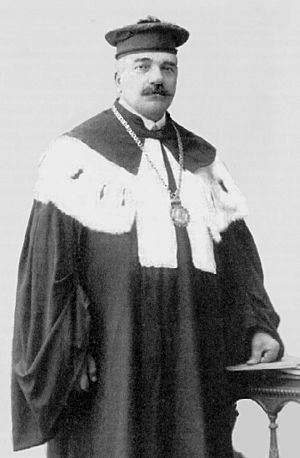Giuseppe Veronese facts for kids
Quick facts for kids
Giuseppe Veronese
|
|
|---|---|
 |
|
| Born | 7 May 1854 Chioggia
|
| Died | 17 July 1917 (aged 63) |
| Nationality | Italian |
| Alma mater | Istituto Tecnico di Venezia |
| Scientific career | |
| Fields | Mathematics |
| Institutions | University of Padua |
| Doctoral advisor | Luigi Cremona |
| Doctoral students | Guido Castelnuovo |
Giuseppe Veronese (born May 7, 1854 – died July 17, 1917) was an Italian mathematician. He was born in Chioggia, a town close to Venice. Veronese made important contributions to the world of mathematics, especially in geometry and understanding different kinds of numbers.
Contents
School Days
Giuseppe Veronese studied mathematics at the Istituto Tecnico di Venezia. He completed his studies and earned his degree in 1872.
His Big Ideas
Veronese was known for his original thinking in mathematics. He explored new ways to understand numbers and shapes.
New Kinds of Numbers
He worked on ideas that are now part of what we call transfinite numbers. These are numbers that are "bigger" than any regular whole number. Imagine counting forever; transfinite numbers help mathematicians talk about different sizes of infinity.
Different Geometries
Veronese also developed a special kind of geometry. It was based on his idea of "relative continuity." This led to the first non-Archimedean linear continuum. This means he created a way to describe lines where distances can behave differently than what we usually expect. It was a very new and complex idea at the time.
Important Books
Veronese wrote several important books about his mathematical ideas. His most famous book came out in 1891. It was called Fondamenti di geometria a più dimensioni e a più specie di unità rettilinee esposti in forma elementare. Most people just called it Fondamenti di geometria.
This book was quite controversial. Some mathematicians, like Peano and Cantor, strongly disagreed with some of his ideas. However, other famous mathematicians, such as Levi-Civita and Hilbert, thought his work was brilliant and very deep. Even though his ideas were debated, Veronese's work helped other mathematicians realize they needed to be very precise and careful in their definitions.
See Also
- Veronese surface
 In Spanish: Giuseppe Veronese para niños
In Spanish: Giuseppe Veronese para niños

